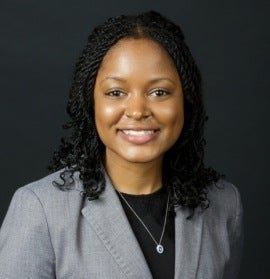The Department is extremely pleased to welcome four distinguished colleagues– Scarlett Bellamy, Aaron Foster, DeJuran Richardson and Alisa Stephens– who will join our adjunct faculty and provide career mentorship for students and junior faculty from historically marginalized groups.
We will be featuring interviews with each adjunct faculty member over the next few weeks.
 Alumna Alisa Stephens-Shields, PhD’12
Alumna Alisa Stephens-Shields, PhD’12
What is your current position at your home institution?
I am an Assistant Professor of Biostatistics in the Department of Biostatistics, Epidemiology and Informatics at the University of Pennsylvania.
What do you enjoy most about your job?
I enjoy that it never gets old. There are always new questions to be investigated, and I’m constantly learning something new about a different disease area or medical condition. I’ve learned about risk factors and markers for progression in chronic diseases, assessment of performance outcomes and quality of life, and the behavioral economics of food purchasing, research participation, and medication adherence. I also enjoy working with students as they discover their own interests and find their place in our field. Finally, I love the flexibility. I’m able to be present for my family in a lot of ways that I am not sure would be possible in other careers or industries.
What research are you currently working on?
My research involves extensions and innovative applications of methodology for causal inference using the potential outcomes framework, often with a focus on improving the design and analysis of randomized clinical trials. My current work focuses on addressing issues of generalizability by integrating observational data into the design of randomized studies and novel approaches to the handling of intercurrent events. I also work on the development of patient reported outcomes to inform population-appropriate primary endpoint selection in future clinical trials.
I further serve as the lead statistical investigator on collaborations in chronic pain, pediatrics, and nutrition and health policy. Examples of research objectives include the development and evaluation of novel therapies to treat interstitial cystitis and bladder pain syndrome, evaluation of practice-level interventions to increase uptake of the HPV vaccine among adolescents, and determining the ethicality of financial incentives to increase participation in research. I’ve developed a salad bowl of collaborative interests based on opportunities and investigators; I’ll work with anyone with an interesting scientific question and collegial disposition. Many of my collaborations utilize my expertise in clustered and longitudinal data and causal inference.
Where did you grow up? Can you point to something in your life that may have influenced your decision to study biostatistics?
I grew up in Teaneck, New Jersey. It’s a small New York City suburb that made its place in history as the first town in the nation to voluntarily integrate its schools in the 1960s. Growing up I was exposed to a lot of math games and puzzles, which piqued my interest in quantitative disciplines. I discovered biostatistics by googling ‘What do people with math majors do?’ after deciding my junior year of college that I no longer wanted to attend medical school. To learn more about biostatistics I did a summer research program at Rutgers University and the University of Medicine and Dentistry. After that I was sold. My last year of undergrad I worked part-time in the Surveillance Research Program at the National Cancer Institute writing R programs to conduct simulations to evaluate various spatial mapping tools. This experience solidified my decision to pursue biostatistics in graduate school.
Can you describe your educational and career pathway and any challenges you faced along the way?
I am a graduate of the public school system in Teaneck, NJ. I declined undergraduate offers of admission at Penn, Princeton, and Yale to accept a full scholarship to the University of Maryland, College Park (Go Terps!), where I earned a BS in Mathematics and a minor in Spanish. After a gap year, during which I did community service in Costa Rica and worked at a law firm in NYC, I enrolled at Harvard Biostatistics. I originally thought that I would return to the government after graduation, but I liked the combination of research and teaching in academia. I was particularly attracted to an academic position at Penn for the opportunity to engage in relevant collaborative research in a methodologically rigorous environment. As a student, the greatest challenges I faced were navigating extremely challenging courses and managing imposter syndrome. As a professional, time management across many projects and personal commitments is tricky.
How do you feel being Black impacted your educational and career opportunities and experiences?
Being Black made me stand out. At times I felt pressure to ‘represent’ as the only black person in certain programs or committees. I remember not discontinuing a prestigious research program that I thought was unproductive for me solely because the only other black students in the program had quit before me, and I didn’t want the program to be void of any black student participation. Socially I sometimes dealt with race-related microaggressions or culturally insensitive comments. Although the impact of these moments was typically short-lived, they interrupted my work flow and placed doubts in my mind about the environment.
What’s the biggest lesson you’ve learned or bit of wisdom you can impart to students or junior faculty from historically marginalized groups?
Allies come in all shapes, colors and sizes. There are mentors, both more senior and peer, who I assumed initially weren’t people that I had any commonalities with, but who ended up being really essential in my journey. Also, put yourself out there. You’re worth other people’s time. Talk to fellow students, faculty, and staff. Attend conferences. Give presentations. I’ve learned so much from synthesizing comments, feedback, and informal conversations over the years that has really shaped how I approach my work.



